人教版初一上册英语课本教案
- 格式:doc
- 大小:26.00 KB
- 文档页数:4
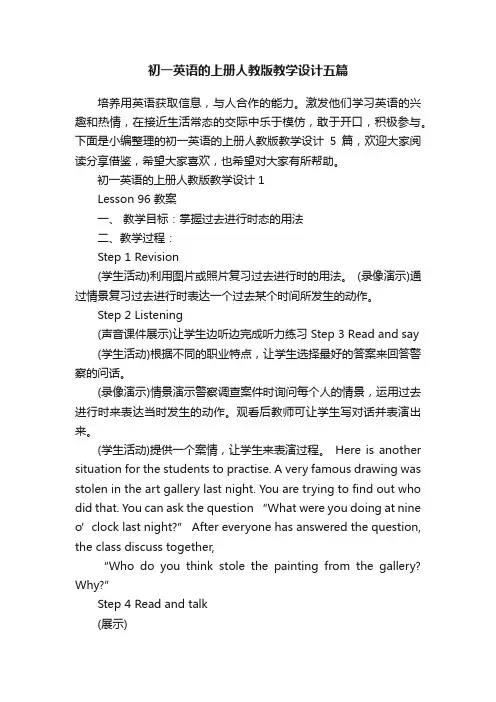
初一英语的上册人教版教学设计五篇培养用英语获取信息,与人合作的能力。
激发他们学习英语的兴趣和热情,在接近生活常态的交际中乐于模仿,敢于开口,积极参与。
下面是小编整理的初一英语的上册人教版教学设计5篇,欢迎大家阅读分享借鉴,希望大家喜欢,也希望对大家有所帮助。
初一英语的上册人教版教学设计1Lesson 96 教案一、教学目标:掌握过去进行时态的用法二、教学过程:Step 1 Revision(学生活动)利用图片或照片复习过去进行时的用法。
(录像演示)通过情景复习过去进行时表达一个过去某个时间所发生的动作。
Step 2 Listening(声音课件展示)让学生边听边完成听力练习 Step 3 Read and say (学生活动)根据不同的职业特点,让学生选择最好的答案来回答警察的问话。
(录像演示)情景演示警察调查案件时询问每个人的情景,运用过去进行时来表达当时发生的动作。
观看后教师可让学生写对话并表演出来。
(学生活动)提供一个案情,让学生来表演过程。
Here is another situation for the students to practise. A very famous drawing was stolen in the art gallery last night. You are trying to find out who did that. You can ask the question “What were you doing at nine o’clock last night?” After everyo ne has answered the question, the class discuss together,“Who do you think stole the painting from the gallery? Why?”Step 4 Read and talk(展示)Read the table about what David was doing at different times yesterday, then ask and answer in pairs.(录像演示)情景演示询问过去某个时间点正在进行的动作,看后让学生进行模仿练习。
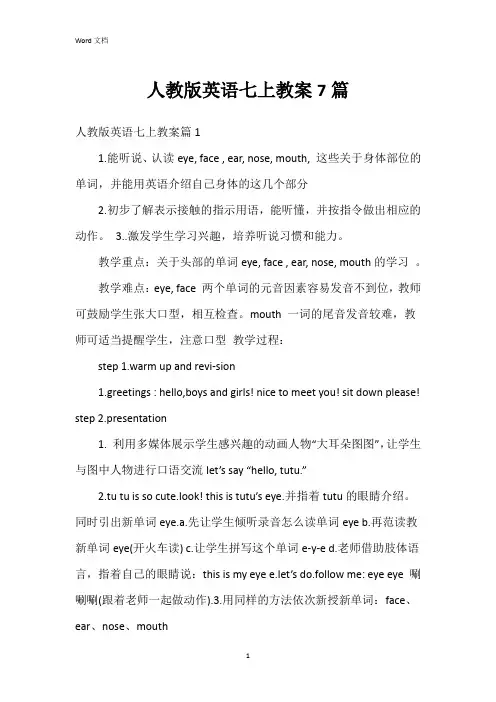
人教版英语七上教案7篇人教版英语七上教案篇11.能听说、认读eye, face , ear, nose, mouth, 这些关于身体部位的单词,并能用英语介绍自己身体的这几个部分2.初步了解表示接触的指示用语,能听懂,并按指令做出相应的动作。
3..激发学生学习兴趣,培养听说习惯和能力。
教学重点:关于头部的单词eye, face , ear, nose, mouth的学习。
教学难点:eye, face 两个单词的元音因素容易发音不到位,教师可鼓励学生张大口型,相互检查。
mouth 一词的尾音发音较难,教师可适当提醒学生,注意口型教学过程:step 1.warm up and revi-sion1.greetings : hello,boys and girls! nice to meet you! sit down please! step2.presentation1. 利用多媒体展示学生感兴趣的动画人物“大耳朵图图”,让学生与图中人物进行口语交流let’s say “hello, tutu.”2.tu tu is so cute.look! this is tutu’s eye.并指着tutu的眼睛介绍。
同时引出新单词eye.a.先让学生倾听录音怎么读单词eye b.再范读教新单词eye(开火车读) c.让学生拼写这个单词e-y-e d.老师借助肢体语言,指着自己的眼睛说:this is my eye e.let’s do.follow me: eye eye 唰唰唰(跟着老师一起做动作).3.用同样的方法依次新授新单词:face、ear、nose、mouth4.powerpoint制作:打开幻灯片后每点击一身体部位就会出现相应的单词。
(注mouth一词的尾音发音较难,适当提醒学生,注意口型。
)5.认读face、ear、eye、nose、mouth的单词卡片和图片。
step3:practice1.let’s do: eye eye 唰唰唰ear ear 呼呼呼nose nose 闻闻闻mouth mouth 巴巴巴face face 拍拍拍2.i say you do.(老师说,学生快速做相应的动作,然后找一位学生出来做出动作。
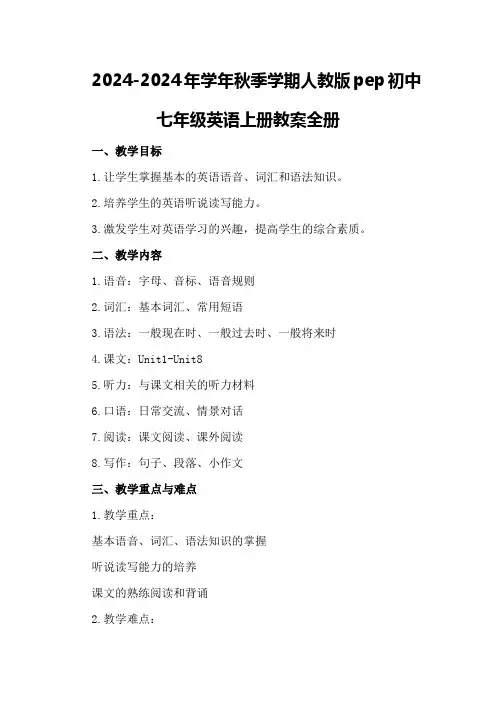
2024-2024年学年秋季学期人教版pep初中七年级英语上册教案全册一、教学目标1.让学生掌握基本的英语语音、词汇和语法知识。
2.培养学生的英语听说读写能力。
3.激发学生对英语学习的兴趣,提高学生的综合素质。
二、教学内容1.语音:字母、音标、语音规则2.词汇:基本词汇、常用短语3.语法:一般现在时、一般过去时、一般将来时4.课文:Unit1-Unit85.听力:与课文相关的听力材料6.口语:日常交流、情景对话7.阅读:课文阅读、课外阅读8.写作:句子、段落、小作文三、教学重点与难点1.教学重点:基本语音、词汇、语法知识的掌握听说读写能力的培养课文的熟练阅读和背诵2.教学难点:音标发音的准确性语法规则的灵活运用课外阅读的理解与分析四、教学进度安排1.第一周:Unit11.1Greetingsandintroductions 1.2Numbersandages1.3Colors2.第二周:Unit22.1Schoolsubjects2.2Classroomobjects2.3Dlyroutines3.第三周:Unit33.1Foodanddrink3.2Describingfood3.3Makingrequests4.第四周:Unit44.1Familymembers4.2Describingpeople4.3Talkingaboutfamily5.第五周:Unit55.1Time5.2Daysoftheweek5.3Activities6.第六周:Unit66.1Weather6.2Clothing6.3Describingtheweather7.第七周:Unit77.1Inthelibrary7.2Intheclassroom7.3Inthesupermarket8.第八周:Unit88.1Sports8.2Describingsports8.3Talkingaboutsports五、教学方法1.采用任务型教学法,让学生在实际语境中学习英语。
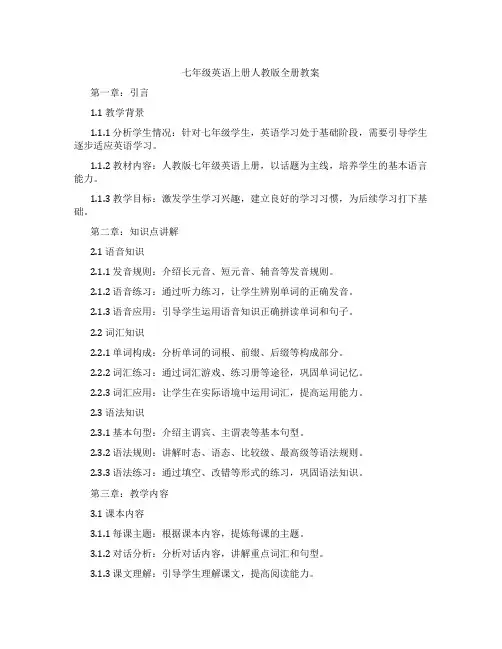
七年级英语上册人教版全册教案第一章:引言1.1 教学背景1.1.1 分析学生情况:针对七年级学生,英语学习处于基础阶段,需要引导学生逐步适应英语学习。
1.1.2 教材内容:人教版七年级英语上册,以话题为主线,培养学生的基本语言能力。
1.1.3 教学目标:激发学生学习兴趣,建立良好的学习习惯,为后续学习打下基础。
第二章:知识点讲解2.1 语音知识2.1.1 发音规则:介绍长元音、短元音、辅音等发音规则。
2.1.2 语音练习:通过听力练习,让学生辨别单词的正确发音。
2.1.3 语音应用:引导学生运用语音知识正确拼读单词和句子。
2.2 词汇知识2.2.1 单词构成:分析单词的词根、前缀、后缀等构成部分。
2.2.2 词汇练习:通过词汇游戏、练习册等途径,巩固单词记忆。
2.2.3 词汇应用:让学生在实际语境中运用词汇,提高运用能力。
2.3 语法知识2.3.1 基本句型:介绍主谓宾、主谓表等基本句型。
2.3.2 语法规则:讲解时态、语态、比较级、最高级等语法规则。
2.3.3 语法练习:通过填空、改错等形式的练习,巩固语法知识。
第三章:教学内容3.1 课本内容3.1.1 每课主题:根据课本内容,提炼每课的主题。
3.1.2 对话分析:分析对话内容,讲解重点词汇和句型。
3.1.3 课文理解:引导学生理解课文,提高阅读能力。
3.2 拓展内容3.2.1 相关话题:针对课本内容,拓展相关话题。
3.2.2 听力练习:选择合适的听力材料,提高学生听力水平。
3.2.3 口语表达:组织口语交流活动,提高学生口语表达能力。
第四章:教学目标4.1 知识目标4.1.1 掌握基本的语音、词汇和语法知识。
4.1.2 能够听懂、说出一日常用语。
4.1.3 理解课本内容,具备一定的阅读和写作能力。
4.2 能力目标4.2.1 提高学生的听、说、读、写四项基本技能。
4.2.2 培养学生的语言运用能力和团队协作能力。
4.2.3 培养学生的跨文化交际意识。
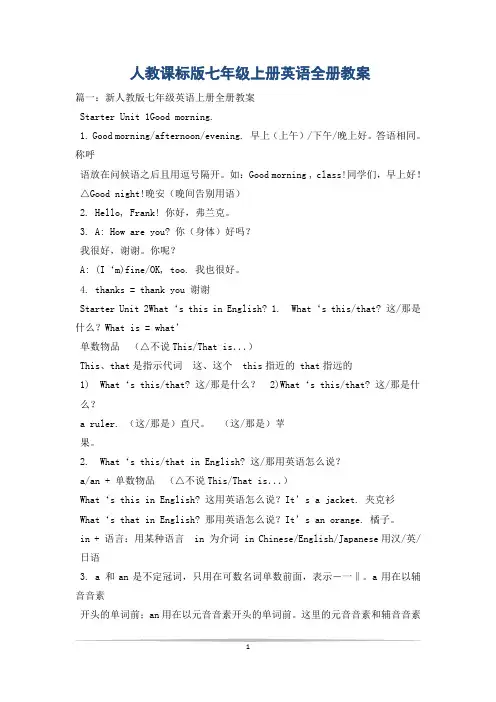
人教课标版七年级上册英语全册教案篇一:新人教版七年级英语上册全册教案Starter Unit 1Good morning.1. Good morning/afternoon/evening. 早上(上午)/下午/晚上好。
答语相同。
称呼语放在问候语之后且用逗号隔开。
如:Good morning , class!同学们,早上好!△Good night!晚安(晚间告别用语)2. Hello, Frank! 你好,弗兰克。
3. A: How are you? 你(身体)好吗?我很好,谢谢。
你呢?A: (I‘m)fine/OK, too. 我也很好。
4. thanks = thank you 谢谢Starter Unit 2What‘s this in English? 1. What‘s this/that? 这/那是什么?What is = what’单数物品(△不说This/That is...)This、that是指示代词这、这个 this指近的 that指远的1) What‘s this/that? 这/那是什么? 2)What‘s this/that? 这/那是什么?a ruler. (这/那是)直尺。
(这/那是)苹果。
2. What‘s this/that in English? 这/那用英语怎么说?a/an + 单数物品(△不说This/That is...)What‘s this in English? 这用英语怎么说?It’s a jacket. 夹克衫What‘s that in English? 那用英语怎么说?It’s an orange. 橘子。
in + 语言:用某种语言 in 为介词 in Chinese/English/Japanese用汉/英/ 日语3. a 和an是不定冠词,只用在可数名词单数前面,表示―一‖。
a用在以辅音音素开头的单词前;an用在以元音音素开头的单词前。
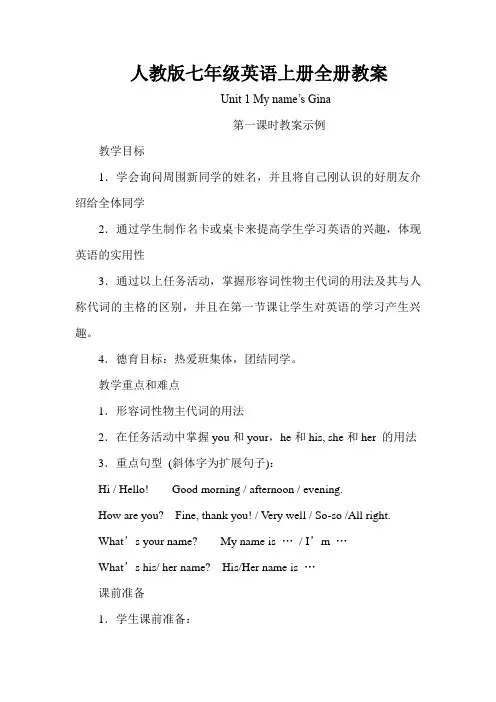
人教版七年级英语上册全册教案Unit 1 My name’s Gina第一课时教案示例教学目标1.学会询问周围新同学的姓名,并且将自己刚认识的好朋友介绍给全体同学2.通过学生制作名卡或桌卡来提高学生学习英语的兴趣,体现英语的实用性3.通过以上任务活动,掌握形容词性物主代词的用法及其与人称代词的主格的区别,并且在第一节课让学生对英语的学习产生兴趣。
4.德育目标:热爱班集体,团结同学。
教学重点和难点1.形容词性物主代词的用法2.在任务活动中掌握you和your,he和his, she和her 的用法3.重点句型(斜体字为扩展句子):Hi / Hello! Good morning / afternoon / evening.How are you? Fine, thank you! / Very well / So-so /All right.What’s your name? My name is …/ I’m …What’s his/ her name? His/Her name is …课前准备1.学生课前准备:利用网络查阅中英文姓名及初次见面时各国或各地风俗,礼仪体会它们的不同之处;准备硬纸片和水彩笔;用英文介绍自己的姓、名。
2.教学器材:录音机、电脑、图片。
3.教学课件:中英文名字展示片。
教学设计Tasks Students’ activities Teacher’s activities1. Game: ask and answer the question: What’s your name? Students make a self-introduction and pass the sentences one by one. At first, teacher makes a self-introduction.2.Two students act out how to greet people. Act out the greeting forms they are familiar with or they find on net. Show the students the pictures of other countries’customs with computer.3. See who can make the most friends and get the most information. Then report their results with his or hers. Move around to make friends with the ones they are interested in. Make the students move around to make friends with others.4. Design and make their name cards . Design and make their name cards in groups. Ask them to design their name cards and see which group is the best.教学过程设计任务一:结识新朋友。
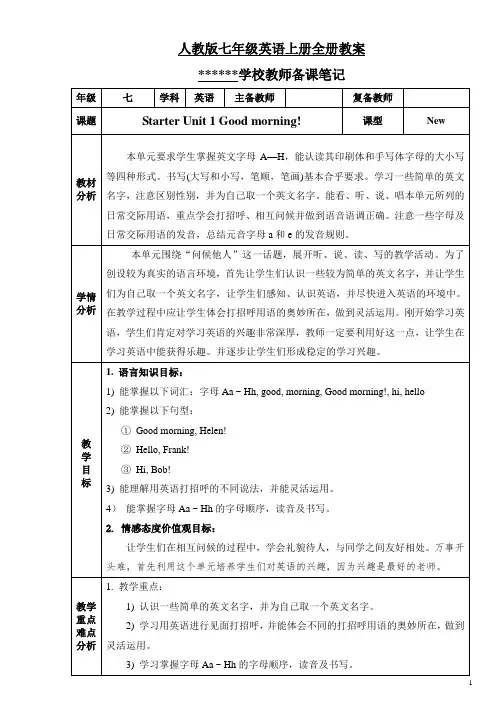
人教版七年级英语上册全册教案******学校教师备课笔记学校教师备课笔记Revise some school things byasking questions. e.g.: What ’s this? Is this a …? How do you spell it?etc.Learn the new words in, on, under, behind … by helping the teacher find the lost things. e.g.: T: Where ’s my English book? S1: It ’s here. / I think it ’s …T: Oh, it ’s on the desk. … T: Where ’re my color pencils? S2: … Teach the new word “where ” and the use of “they ”. Consolidate the prepositions by looking at thescreen and answer thequestions: Where ’s … ?Where ’re …?Hide and look for thingsShow the students a picture of a room, tell them this is a bedroom, let the students list the things in it first. Then show them the whole picture, teach the new words, ask where the things are, let the students answer, using the prepositions.Repeat with a sitting room and a study, teach the new words and practice in the same way.Section A, 1a: Match the words with the things in the picture. Students do it individually first, then check the answers. Section A, 1c: Make up dialogues in pairs, using the things in the picture.Chatting. Chat with the students about the things around the room by showing them pictures. Ask the students to spell the new words. Section A, 2a. Revise what the things are. Play the tape for students and let them number them. Section A, 2b. Play the tape again, students number the things [1-6] in the picture. Imitate the dialoguesSection A, 2c. Look at the picture in 2b again. Students use general questions to ask and answer about the things in it.Ask some students to report their answer like this: In Picture 1, the pencil case is …In Picture 2, the pencil case is…; In Picture 1, the books are …In Picture 2, the books are …Present short dialogues, using pictures or objects to help. Dialogue 1: A: Where’s my bag? B: I don’t know. Is it on the sofa? A: No, it isn’t. Dialogue 2: A: Where’re my books? B: I don’t know. Are they on the bed? A: Yes, they are. Teach “don’t =do not”, “know”. Check the homework in Period One. Make reports to share the information they got from the friends or teachers, and give their simply assessment.Let the students makesimilar dialogues according to the pictures in Section A, 3a&3c. Put the dialogue in the right order.( Section A, 3a.) Listen and imitate the dialogues in Section A, 1b.answer make similar dialogues according to the pictures in Section A, 3a&3c.Ask some pairs to act out the dialogues in Section A, 2a & 2b. Show the students a picture of a room. Let the students say likethis: The ID card is on the table. The books are on the chair. Let some able students list some new words. Practice reading them. Match the new words with the things in thepicture. (Section B, 2a.) Pairwork. Talk about the picture.( Section B, 1b&1c.)Play the tape twice for students to listen and circle the things Tommy wants from his room. Check the answers. ( Section B, 2a. )Listen again.Show a picture of a roomwith a few things in it, give the students a short note about the things around the room to read, let the students try to find out thedifferences between the reading material and the picture. Circle the mistakesin the reading material. Make an orally report by looking at the picture again. The students read the note silently and draw the missing things in the picture. ( Section B, 3a.) (为了节省时间,教师可以让学生在图中标出数字来替代画图。
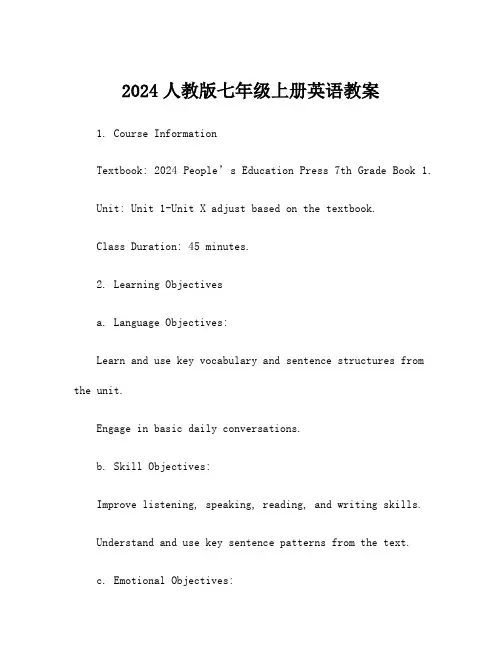
2024人教版七年级上册英语教案1. Course InformationTextbook: 2024 People’s Education Press 7th Grade Book 1.Unit: Unit 1-Unit X adjust based on the textbook.Class Duration: 45 minutes.2. Learning Objectivesa. Language Objectives:Learn and use key vocabulary and sentence structures from the unit.Engage in basic daily conversations.b. Skill Objectives:Improve listening, speaking, reading, and writing skills.Understand and use key sentence patterns from the text.c. Emotional Objectives:Foster interest and confidence in learning English.Enhance teamwork and communication skills.3. Lesson ContentText: Dialogues, short texts, and stories from the unit.Vocabulary: New words and phrases from the unit.Grammar: Key grammar points from the unit.Functional Sentences: Core sentences and expressions from the unit.4. Teaching Stepsa. Introduction (5 minutes)Use images, videos, or questions to introduce the lesson theme.Engage students and outline the learning objectives.b. New Content (15 minutes)Vocabulary: Introduce and explain new words, focusing on pronunciation, spelling, and meaning.Grammar: Explain key grammar points with examples.Sentence Patterns: Demonstrate core sentence structures and practice.c. Text Learning (10 minutes)Read the text aloud and discuss its content.Engage in group discussions or role-plays to practice dialogues.d. Practice (10 minutes)Complete related exercises such as fill-in-the-blanks, matching, and multiple-choice questions.Use group activities or games to reinforce vocabulary and sentence structures.f. Summary and Homework (5 minutes)Review the lesson’s content and address any student questions.Assign homework, such as vocabulary practice, writing tasks, or reading assignments.5. Homework AssignmentsVocabulary Practice: Complete exercises from the textbook.Writing Task: Write a short paragraph using the new vocabulary and sentence structures.Listening Exercise: Listen to recordings and complete related comprehension questions.6. AssessmentOral Evaluation: Assess student participation and performance in class.Written Evaluation: Evaluate homework and exercise accuracy.7. ReflectionReflect on the effectiveness of the lesson based on student feedback and observation.Note areas for improvement for future lessons.。
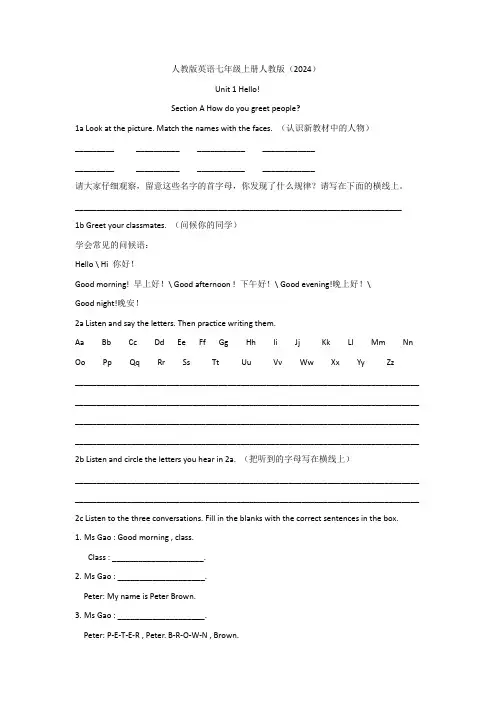
人教版英语七年级上册人教版(2024)Unit 1 Hello!Section A How do you greet people?1a Look at the picture. Match the names with the faces. (认识新教材中的人物)_________ __________ ___________ _____________________ __________ ___________ ____________请大家仔细观察,留意这些名字的首字母,你发现了什么规律?请写在下面的横线上。
___________________________________________________________________________1b Greet your classmates. (问候你的同学)学会常见的问候语:Hello \ Hi 你好!Good morning! 早上好!\ Good afternoon ! 下午好!\ Good evening!晚上好!\Good night!晚安!2a Listen and say the letters. Then practice writing them.Aa Bb Cc Dd Ee Ff Gg Hh Ii Jj Kk Ll Mm Nn Oo Pp Qq Rr Ss Tt Uu Vv Ww Xx Yy Zz_______________________________________________________________________________ _______________________________________________________________________________ _______________________________________________________________________________ _______________________________________________________________________________ 2b Listen and circle the letters you hear in 2a. (把听到的字母写在横线上)_______________________________________________________________________________ _______________________________________________________________________________ 2c Listen to the three conversations. Fill in the blanks with the correct sentences in the box.1.Ms Gao : Good morning , class.Class : _____________________.2.Ms Gao : ____________________.Peter: My name is Peter Brown.3.Ms Gao : ____________________.Peter: P-E-T-E-R , Peter. B-R-O-W-N , Brown.2d Make up a conversation to greet each other.A: Good morning.B: ____________________. What’s your name?A: ___________________________.B: How do you spell your name ?A: _____________________.B: Goodbye.A: ______________________.Pronunciation1 Listen to the 26 letters. Find then on the keyboard. Then practice with a partner. Where is A?A is here.2 Listen and repeat the letters.1./e ɪ / Aa Hh Jj Kk2./i:/ Bb Cc Dd Ee Gg Pp Tt Vv Zz3./e/ Ff Mm Nn Ss Xx Zz4./ai / Ii Yy5./ju:/ Qq Uu Ww6./əʊ/ Oo7./a:/ Rr3 Listen to these letters. Match them with the pictures.1.PLA _________________2.VR __________________3.CD __________________4.PRC ___________________5.UN ___________________4 Listen and sing the songA ,B ,C ,D ,E ,F ,G ,H , I , J , K , L , M , N ,O , P , Q , R , S , T .U , V , W , X , Y , Z.X , Y , Z —now you see ,I can say my ABCs.本部分知识点回顾:1、问候他人:一天的各个时间段遇见,用Good + 时间;例如:Good morning ! 早上好!\ Good afternoon ! 下午好!\ Good evening ! 晚上好!\ Good night ! 晚安!Hello , Hi 用于向他人问候。
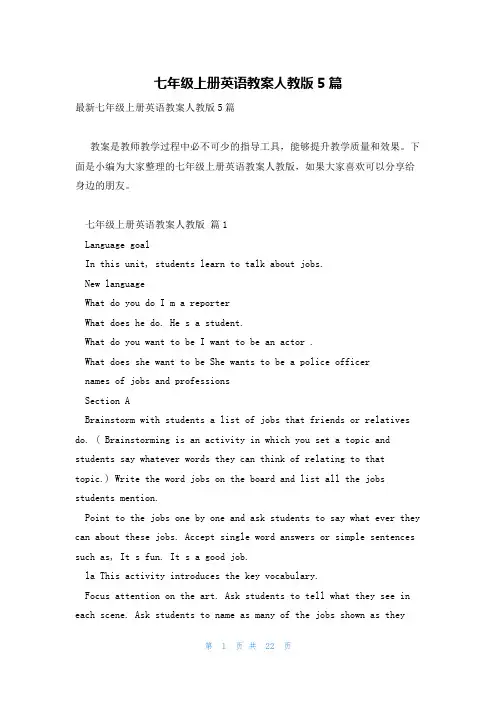
七年级上册英语教案人教版5篇最新七年级上册英语教案人教版5篇教案是教师教学过程中必不可少的指导工具,能够提升教学质量和效果。
下面是小编为大家整理的七年级上册英语教案人教版,如果大家喜欢可以分享给身边的朋友。
七年级上册英语教案人教版篇1Language goalIn this unit, students learn to talk about jobs.New languageWhat do you do I m a reporterWhat does he do. He s a student.What do you want to be I want to be an actor .What does she want to be She wants to be a police officernames of jobs and professionsSection ABrainstorm with students a list of jobs that friends or relatives do. ( Brainstorming is an activity in which you set a topic and students say whatever words they can think of relating to that topic.) Write the word jobs on the board and list all the jobs students mention.Point to the jobs one by one and ask students to say what ever they can about these jobs. Accept single word answers or simple sentences such as, It s fun. It s a good job.la This activity introduces the key vocabulary.Focus attention on the art. Ask students to tell what they see in each scene. Ask students to name as many of the jobs shown as theycan. Then point to a scene, name the job, and ask students to repeat. Point to the numbered list of words. Say each one and ask students to repeat.Then ask students to match each word wllfa one of the scenes. Say, Write the letter of each scene next to one of the ivords. Point tothe sample answer.1 b This activity gives students practice in understanding thetarget language in spoken conversation.Point to the different people shown in the picture.Ask various students to tell what they do as you point to each one,Say, Now you will hear three conversations. The conversations are about three of the people in this picture.Play the recording the first time. Students only listen.Play the recording a second time. This time ask students to write a number 1 next to the person being talked about in conversation 1. Have students put a 2 and 3 next to the people being talked about in conversations 2 and 3.Correct the answers.1 c This activity provides guided oral practice using the target language-Ask a student to read the example conversation with you. Hold upthe book and point to the doctor in the picture.Say, Now work with your partner. Make your own conversations about the picture. You can use sentences like the ones in activity 1b.Say a dialogue with a student. Point to a picture of one of the people. Guide the student to answer using one of the words inactivity 1a.As students work in pairs, move around the room monitoring theirwork. Oner language or pronunciation support as needed.2a This activity gives students practice in understanding thetarget language in spoken conversation.Ask students to look at the three pictures. Ask different students to tell you what they sec in each picture. What are the people doing What jobs do they havePlay the recording the first time. Students only listen.Say, You will hear conversations about the people in these pictures.Play the recording a second time. Say, Write the number of each conversation below the picture of the person being talked about.Correct the answers.2b This activity gives students practice in understanding thetarget language in spoken conversation.Point to the three headings in the chart and read the headings to the class. Ask students, What does wants to be mean (It is not the Job the person lias now. It is the job the person wants in the future.)Play the recording the first time. Students only listen.Say, You wiU hear about the people in these pictures. You will hear the job they haw now and the job they want in the future.Play the recording a second time. This time ask students to fill in the blanks with the jobs the people have now and the ones they wantin the future. Point out the sample2c This activity provides guided oral practice using the target language.Point out the pictures in activity 2a. Ask who each person is. (They are Susan s brother. Anna s mother, and Tony s father.)Say, Now work with your partner. Ask and answer questions about thepictures. Ask, What does he or she do Then ask, What does he or she want to beSay a dialogue with a student. Point to Anna s mother and then to the example in the speech balloons. Practice the dialogue with a student.As students work In pairs, move around the room monitoring their work. Offer language support as needed.3a This activity introduces the names for the places where people work, and gives reading practice using the target language.Call attention to the pictures. Ask students to read the name for each place. As they name each place, write the word on the board and-ask the class to repeat it.Point out the list of jobs with the numbers next to each. Then call attention to the people in the pictures and the speech bubbles. Point out the sample answer and have a student read out the speech bubble. Ask students to work alone. Say, Write the number of each job in the square next to each workplace.Check the answers.3b This activity provides guided oral practice using the target language.Point out the pictures in activity 3a. Ask students to name the workplace shown In each picture.Then point out the conversation in the speech bubbles. Ask two students to read It to the class.Say, Wow work with a partner. First practice the conversation in the picture. Then make new conversations. Use jobs and places from activity 3a.Say a dialogue with a student. Point to the word waiter in activity3a and then to the picture of the restaurant. Ask a student. Where does he work Guide the student to answer using the correct place: He works in a restaurant.Then ask. What does he do and guide the student to answer, He s a waiter.As students work in pairs, move around the room monitoring their work. Offer language support as needed.4 This activity provides listening and speaking practice using the target language.Call attention to the pictures in the book showing how to play the game. Say, You will draw a picture of someone working. Other students will ask questions about the kind of job you are drawing. After two questions someone can try to guess the job.Demonstrate by drawing a picture on the board of a stick figure reporter. Add details (microphone, notebook,etc.) until students guess what job it is.Ask a student to go to the board. Say, Draw a picture of a person working. If necessary, help the student add details that show the job the person is doing. He or she can add a bank interior to show that the person is a bank clerk. A student could also use an eye chart on the wall to show that the place is a doctor s office and the personis a doctor.Ask two different students to ask questions about the Job, and then ask a third student to guess what job it is.Play the game using drawings by several different students.Alternative: If you do not want students to move from their seats, then you can ask them to do this activity sitting down in groups of four. They will need pieces of paper on which to draw their pictures. They will also need pencils.Section BNew languageWords that describe jobs, such as exciting, dangerous,boring, difficult, busy, funAdditional materials to bring to class:help wanted ads from an English-language newspaper1 a This activity introduces the key vocabulary.Focus attention on the six pictures. Ask, What job does the person have Where does the person ivnrkPoint out the numbered list of words. Say each one and ask students to repeat. Then use simple explanations and short sample sentences to help students understand what each word means. For example, Exciting means very interesting and very fast-moving. A police officer has an exciting job. The job is always changing. Something is always happening. For dangerous you might say, Dangerous means not safe. You might be hurt or killed in a dangerous job.Then ask students to match each word with one of the pictures. Say, Write the letter of each picture next to one of the words. Point out the sample answer.Check the answers.1 b This activity provides guided oral practice using the target language.Call attention to the picture In this activity and ask a student to read the statement to the class. Then point to the picture of the police officer and say. It s an exciting job. Ask the class to repeat. Then say, What else can you say about being a police officer Someone may answer, It s a dangerous job. Ask the class to repeat each correct answer.Then ask students to work in pairs. Suggest that they each point to the pictures of the workers and make statements about them. As students practice, move around the classroom monitoring their work.1 c This activity provides an opportunity for oral practice.Say, Name some of the jobs from this unit. Write this list of jobs on the board. Say, Can you name some other jobs Add any new jobs to the list.Ask some students to make statements about Jobs on the list using the words in activity la. You may wish to write some of the sentences on the board so that students can copy the sentences into their notebooks.2a This activity provides listening and writing practice with the target language.Call attention to the two headings and ask a student to read die headings to the class.Point out the blank lines where students will write the name of a job (under the words wants to be).Play Ihe recording the first time. Students only listen.Say, Now I will play the tape again. This time write the name of a job under the words wants to be.2b This activity provides listening and writing practice with the target language,Call attention to the second heading and ask a student to read it to the class. Say, This time you will unite why each person wants the job.Play the recording again. Students only listen.Then say, Now I will play the tape again. This time write the reason the person wants the job under the word WhyPlay the recording. Students write their answers.Check the answers.2C This activity provides open-ended oral practice using the target language.Say, What do you want to be What words describe each job Help the class make up a list of jobs they might like to do. As students suggest possible jobs, ask the class to suggest words to describe them. Use a bilingual dictionary, if necessary, to find the names of jobs and words to describe each one.Then ask students to work in small groups. They tell each otherwhat they want to do and why. Encourage students to use dictionariesif necessary. Move from group to group offering assistance as needed. Ask individual students to tell the class about what they want tobe and why.3a This activity provides reading and writing practice using the target language.Call attention to the three newspaper ads and read these ads to the class. Say blank each time you come to a blank line.Then read each ad again separately, pausing to allow students toask questions about anything they don t understand. For example, in the first ad, students may not know that working late means workingat night. To work hard means to use a lot of energy to do the job.Ask students to fill In (he blanks in the ads using the words actor, reporter, and waiter.Check the answers.3b This activity provides reading and writing practice using the target language.Call attention to the newspaper ad and ask a student to read it,saying blank for each blank line.Ask students to fill in the blanks using words from This section. Say,Look at the pictures next to each blank line. The pictures will help you guess the correct word.Suggest that they look at the names of jobs and the words that describe jobs in the first part of Section B.Check the answers,3c This activity provides writing practice using the targetlanguage.Point out the blank strip of newspaper where students can write their own ads.Ask one or two students, What are you going to write about Repeat each of the students sentences and ask the class to repeat the sentences after you. For example: Do ^OM want an interesting but dangerous job Do you want to meet new people We need a police officer.Call the Smithtown Police Station at 555-2323.Ask students to read their ads to a partner. Ask the pairs to correct each other s work.4 This activity provides guided oral practice using thetarget language.Ask two students to read the conversation in the speech bubbles. Answer any questions students may have about it.Then say, New please work in groups. Ask efuestions to find out what jobs each person wrote about. You can use sentences like the ones we just read.As students ask questions, move from group to group. Rephrase any incomplete or incorrect questions.Also rephrase any inaccurate answers.七年级上册英语教案人教版篇2Unit 3 Language in use课型 Revision and application教材分析 Unit 3 对“自我介绍和获取信息”的功能句式进行综合训练:谈论自己或朋友的情况(活动1);根据提示完成介绍图片中人物情况的句子;填表、匹配复习表示国家、民族及人物活动的词汇。

人教版7上英语教案5篇(实用版)编制人:__审核人:__审批人:__编制单位:__编制时间:__年__月__日序言下载提示:该文档是本店铺精心编制而成的,希望大家下载后,能够帮助大家解决实际问题。
文档下载后可定制修改,请根据实际需要进行调整和使用,谢谢!并且,本店铺为大家提供各种类型的实用资料,如工作计划、汇报材料、心得体会、发言稿、合同大全、申请书、演讲稿、作文大全、教案大全、其他资料等等,想了解不同资料格式和写法,敬请关注!Download tips: This document is carefully compiled by this editor.I hope that after you download it, it can help you solve practical problems. The document can be customized and modified after downloading, please adjust and use it according to actual needs, thank you!Moreover, our store provides various types of practical materials for everyone, such as work plans, presentation materials, reflections, speech drafts, contract summaries, application forms, speech drafts, essay summaries, lesson plans, and other materials. If you want to learn about different data formats and writing methods, please stay tuned!人教版7上英语教案5篇教案的实施需要教师具备良好的组织和管理能力,以确保教学过程的顺利进行,编写详细的教案可以帮助我们更好地运用各种教学方法和策略,提高教学的多样性,以下是本店铺精心为您推荐的人教版7上英语教案5篇,供大家参考。
七年级英语上册人教版全册教案第一章:Unit 1 My name's Gina.教学目标:1. 能够听懂、说出一系列关于个人信息的问题和答案。
2. 能够正确使用人称代词和形容词性物主代词。
3. 能够通过图片和情景理解简单的英语对话。
教学内容:1. 引入新课:通过一张包含不同人种的图片,让学生观察并讨论。
2. 展示教材插图和单词卡片,引导学生学习生词。
3. 讲解人称代词和形容词性物主代词的用法。
4. 分组练习对话,让学生模拟情景,进行角色扮演。
5. 完成课本练习题,巩固所学内容。
第二章:Unit 2 This is my sister.教学目标:1. 能够听懂、说出关于家庭成员的英语单词和短语。
2. 能够正确使用指示代词和形容词性物主代词。
3. 能够描述家庭成员的外貌特征。
教学内容:1. 引入新课:通过一张包含家庭成员的图片,让学生观察并讨论。
2. 展示教材插图和单词卡片,引导学生学习生词。
3. 讲解指示代词和形容词性物主代词的用法。
4. 分组练习对话,让学生模拟情景,进行角色扮演。
第三章:Unit 3 Please open the window.教学目标:1. 能够听懂、说出关于日常生活中的祈使句。
2. 能够正确使用动词短语。
3. 能够根据情景进行简单的交际。
教学内容:1. 引入新课:通过一个日常生活中的场景,让学生观察并讨论。
2. 展示教材插图和单词卡片,引导学生学习生词。
3. 讲解祈使句的用法和动词短语的构成。
4. 分组练习对话,让学生模拟情景,进行角色扮演。
5. 完成课本练习题,巩固所学内容。
第四章:Unit 4 Is this your schoolbag?教学目标:1. 能够听懂、说出关于物品所有格的英语单词和短语。
2. 能够正确使用一般疑问句和回答。
3. 能够描述物品的特征。
教学内容:1. 引入新课:通过一张包含不同物品的图片,让学生观察并讨论。
2. 展示教材插图和单词卡片,引导学生学习生词。
人教版七年级上册英语教案16篇人教版七年级上册英语教案(精选篇1)一、复习指导思想新授课结束后,期末考试前,指导学生进行期末复习,主要复习基础知识,提高做题能力,训练阅读、听力与写作,使学生能够举一反三,熟练掌握知识点与考点.二、学生学习水平现状分析学生的主要问题是基础薄弱,做题能力参差不齐,优秀的学生不多,成绩有待于提高的学生比较多,一部分同学学习惰性强。
三、复习时间:十七周至十八周(共10课时)四、复习重点1、基础知识:unit1—unit8:重点词汇、短语、句型2、语法:(1)动词不定式(2)动名词(3)被动语态(4)形容词相关句型的运用(5)副词的运用(6)原因状语从句(7)过去进行时3、阅读训练(报纸阅读材料)4、听力(报纸、导学案套题听力训练)5、话题写作:肢体语言,义务工作,传统技艺,卡通漫画、动物保护、动物描写、未来生活畅想6、复习中注重讲练结合,及时反馈,及时检测五、课时安排时间为两周,具体计划如下:十七周(周一)unit1、2重点词组句型小结;语法训练(报纸2、3版)十七周(周二)unit1、2知识点练习,话题写作训练(报纸4版)十七周(周三)unit3、4重点词组句型小结;语法训练(报纸5、6版)十七周(周四)unit3、4知识点练习,话题写作训练(报纸7版)十七周(周五)unit5、6重点词组句型小结;语法训练(报纸8、9版)十八周(周一)unit5、6知识点练习,话题写作训练(报纸10版)十八周(周二)unit7、8重点词组句型小结;语法训练(报纸11、12版)十八周(周三) unit7、8知识点练习,话题写作训练(报纸13版)十八周(周四)模拟套题(报纸31版)(综合测试一)十八周(周五)模拟套题(报纸32版)(综合测试二)六、复习措施1、单词过关。
每天重点句子听写2、语法复习注重讲练结合,引导学生说出重点与易错点3、加强整理英语学习档案4、对于阅读训练有指导,有检测。
最新人教版七年级英语上册教案(完整版)最新人教版七年级英语上册教案(完整版)Starter Unit 1 Good morning !Starter Unit 1 是Go for it!预备篇三个单元的第一单元。
预备篇是为了使那些没有英语基础的学生更好地使用本套教材而编写的。
它的主要内容为26个字母和最基本的英语日常用语。
本单元的教学内容为:1.学习AaHh八个字母。
2.学习八个人名。
Alice, Bob, Cindy, Dale, Eric, Frank, Grace, Helen 3.学习打招呼的用语:Hello!/ Good morning!/ Good afternoon!/ Good evening!4.学会问候熟识的朋友和应答: How are you?I’m fine, thanks. How are you?I’m OK教学重点:AaHh的字母教学。
Hello! Good morning. Good afternoon. Good evening.How are you?I’m fine, thanks. How are you?I’m OK.教学难点:课本中英语人名的学习和大、小写字母的学习及书写。
单元课时:5个课时第一课时:完成Section A 1a, 1b第二课时;完成Section A 2a, 2b,2c, 2d, 3, 4a第三课时:完成 Section A 4b, 4c, Section B 1, 2a, 2b第四课时:完成 Section B 3a, 3b, 4, 5第五课时:完成 Self Check and Just for Fun教学目标A.语言知识目标1.词汇: Letters AaHh八个人名 Alice, Bob, Cindy, Dale, Eric, Frank, Grace, Helen2.句型:Good morning. Good afternoon. Good evening.How are you?I’m fine, thanks. How are you?I’m OK.B. 语言技能目标通过游戏等多种形式的学习活动,培养学生对初学知识的听、说、读、写能力和灵活运用初学的日常交际用语的能力。
人教版(新目标)初中七上Starter Unit 1 Good morning!教案教学目标:1. 学会打招呼的用语:Hello! / Good morning! / Good afternoon! / Good evening!2. 识别和掌握八个人名: Alice, Bob, Cindy, Dale, Eric, Frank, Grace, Helen教学重点、难点:1.词汇:Alice, Bob, Cindy, Dale, Eric, Frank, Grace, Helen2.句型:Hello! Good morning!教学过程:Step 1. Warming-up1. 课前—上课铃响教师就播放Good morning歌曲。
2. 师生初次见面,教师通过自我介绍和问候学生,让学生放轻松,消除与教师间的陌生感,开始亲近教师。
教师自我介绍并用Hello! / Good morning! 问候学生。
帮助学生用Hello! / Good morning! 作回应。
Step 2. Play a game.绝大多数学生都会背诵26个字母表,因此学生参与这个游戏会相当积极。
通过这个游戏首先可以锻炼他们迅速反应的能力;以英语名字作为奖励(老师提前准备好很多的英文名字),也使学生较有新鲜感,让他们自己选择自己的名字,使他们会更容易记住自己的名字。
Play the game like this: Teacher says a letter, for example C, then let the Students tell the letters which is before and after C. The one who says B, D first is the winner. The winner can get a chance to choose an English name first.Step 3. Presentation1.用预先制作的图片或挂图介绍八个人物和姓名。
人教版初一英语上册教案精选15篇教案可以帮助教师明确教学的目标和要求,指导教师在课堂上进行教学活动。
下面是小编为大家整理的人教版初一英语上册教案,如果大家喜欢可以分享给身边的朋友。
人教版初一英语上册教案【篇1】一、指导思想虽然大部分学生在小学已接触过英语,但学生以前不大重视英语,造成英语两极分化严重,且学习积极性低。
所以,现阶段最重要的是激发学生学习英语的兴趣和积极性,帮助他们增强信心,克服困难。
除了从思想上给予引导之外,在教学上,有针对性、目的性、有系统、有计划地上好课。
二、班级基本情况:本学期我担任七年级的英语课。
绝大多数学生虽然小学阶段都学过英语,但大部分学生的英语基础都比较差。
缺少学习的主动性和热情,自觉性也较差,相应的学习习惯也较差,对学习英语有为难情绪。
针对这些情况,在本学期的英语教学中,本人将致力于:一方面,应加强英语基础知识的讲解和基本技能的训练,让学生掌握词汇、语法、句型的基础知识和听、说、读、写等基本技能,为进一步学习英语打下坚实的基础;另一方面,又要采取多种措施,注意培养学生对英语学习的兴趣;让学生掌握记忆语音、单词、阅读和写作等英语学习技巧,培养良好的学习习惯和自主探索、合作探究能力,充分调动学生的学习积极性和主动性。
教学上采取任务型教学方式,运用灵活多变的方法,实现学生语言运用能力的迁移和拓展。
尊重并理解学生,与学生一起分享学习中的苦与乐,使每一位学生的英语成绩有所提高,有所进步。
三、七年级上册英语教学重、难点:(一)、语法知识点.1.一般疑问句及回答;2.指示代词、人称代词、物主代词3.名词复数的变化;4.方位介词;5.特殊疑问句的构成、回答和对划线部分提问6.实义动词的第三人称单数及变化;7、名词所有格;8、一般现在时9、时间表达法;(二)、交际用语。
四、七年级上册英语教学措施初一年级是英语学习的基础阶段,也是养成好习惯的关键时期。
基础打不好、习惯不良,直接影响学生整个初中阶段,乃至高中、大学的英语学习。
人教版初一上册英语课本教案
第1课时Unit3Thisismysister.
SectionA1a—2d
教师寄语:Onecannotputbacktheclock.时钟不能倒转学习目标:1.掌握本节课的13个单词.
2.初步介绍一下复数的概念.
3.学会运用介绍人的句型:This/thatis...以及these/thoseare
和询问人的句型Isthis/that...
学习重难点:掌握指示代词this/these,that/those的用法
学习过程:
一、自主学习
学习任务一:熟练掌握本节课的词汇.
1.个人试读,组内相互纠正发音.
2.老师领读,学生自己纠正自己的发音.
3.自己读并记住汉语意思,组内检查.
4.小组竞赛,看谁记的多而快.
5.认真观察1a的图片,将单词与图中的人物搭配,小组讨论并核对答案.
6.听录音,完成1b,小组核对答案.
学习任务二:1.听录音,完成2a.2b,小组核对答案.
2.介绍家人,引入复数的概念.
Thisismyf________,andthisismym________.Theyaremyp__ _______.
把下列单词变为复数形式.
mother—__________father—_________brother—_________sister—________
friend—___________grandfather—____________grandmother—____________
总结名词变复数的规则:______________________________________
不规则变化this—__________that—_________is—__________
学习任务三:熟练运用介绍人的句型:This/thatis以及These/thoseare和询问人的句型Isthis/that┅
1、看图片1a,引入:ThisisDave.Thisishissister.
2、用Thisis┅Theseare┅句型依次介绍Dave的其他家人。
3、小组竞赛看谁介绍的最多.
二、合作共建
小组讨论:远处的人应如何介绍?
三、系统总结
总结如何介绍自己的家人.
四、诊断评价
(一)英汉互译
hisfriends___________theseboys___________hergrandmo ther____________
你的父母亲___________他的妹妹们____________那些女孩们____________
(二)选择
1.Thesearemy_______________.AfatherBmotherCparentsD parent
2.This______ZhaoLin,MissBrown.
AisBareCamCyour
3.Thisis_______apple.Thoseare___________.
Aa,bananaBan,bananaCan,bananaDa,bananas
(三)用单词的适当形式填空.
1.Look,thisis_________(I)mother.
2.Thesearehis________(parent).
3.Hisfather_____(be)ateacher.
4.Myfriends_____(be)students.
【中考连接】(四)据句意和汉语填空.
1.Myfatherandmymotheraremy_________.
2.Thisismysister.______nameisMary.
3.Whatarethese?Theyare________.(苹果)
4.Thosearemy_________(弟弟们).
5.Yourmother’smotherisyour__________.
(五)汉译英
1、这些是你的朋友吗?
Are________________________________?
2、那些是他们的尺子吗?不,不是.
__________________their__________?
No,_______________.
五、课后反思
通过本节课的学习,我的收获是_________________________________.
感到自己有待加强的_____________________________________________.。